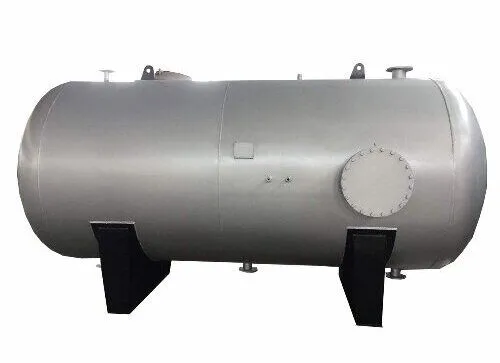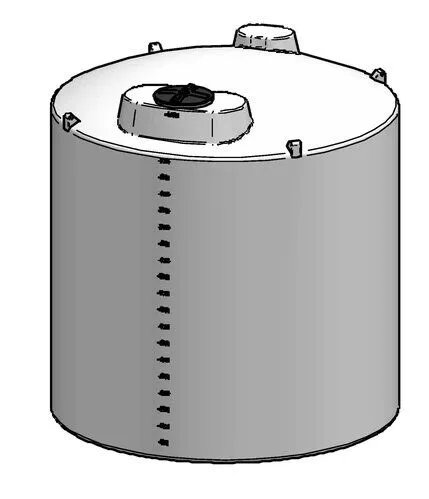Choosing Between Horizontal and Vertical Storage Tanks
On this page
Storage tanks are vital for holding liquids and gases, with the main types being horizontal and vertical. While both serve similar purposes, they differ notably in shape, footprint, and design requirements. Horizontal storage tanks, with their low-profile design, are ideal for large-volume storage and easy maintenance. In contrast, vertical storage tanks, which save space, are suited for environments where height is a factor. Understanding these differences helps in selecting the right storage tank for optimized storage efficiency and operational convenience.
Basic Concepts
Horizontal Storage Tank: The tank is laid horizontally, with a wider bottom and an overall horizontal layout. Due to its larger footprint, it is suitable for occasions that require large-volume storage and is more commonly used in outdoor environments.
Vertical Storage Tank: The tank is placed vertically, with a smaller bottom and an overall vertical layout. Due to its smaller footprint, it is more suitable for indoor use where space is limited, especially in situations that require a higher storage height.
Shape and Footprint
The shape and footprint of the storage tank directly affect its applicable scenarios and operation methods. There are significant differences between horizontal and vertical tanks in this regard, with each designed to meet different usage needs.
1. Horizontal Storage Tank Shape and Footprint
Footprint: The footprint is large, suitable for spacious environments such as factory workshops and gas stations.
Advantages: Due to its low-profile design, materials can be fed in by gravity flow without the need for additional pumps; the bottom flange design facilitates complete discharge, saving time and labor.
Maintenance: Since the tank body and support frame are relatively low, maintenance and cleaning can usually be performed by entering the tank interior using a ladder, which is relatively convenient.

2. Shape and Footprint of Vertical Storage Tank
Footprint: The footprint is small, suitable for environments with limited space, such as factory interiors and laboratories.
Disadvantages: Materials need to be pumped to the top of the tank during feeding, and discharge may not be complete due to the flat bottom design, which is not conducive to complete discharge.
Maintenance: Due to the height, maintenance and cleaning are more troublesome, especially for taller tanks, often requiring the construction of scaffolding to ensure construction safety, which is time-consuming and costly.

Design Considerations
The design of the storage tank involves many aspects, including structural stability, pressure resistance, and environmental adaptability. The design considerations for horizontal and vertical tanks differ in these aspects.
1. Wind Load and Bending Moment
Horizontal Storage Tank: Due to the lower height of the tank, wind load usually does not need to be considered. However, the bending moment caused by the tank's own weight must be considered to ensure the stability of the tank when laid horizontally.
Vertical Storage Tank: Due to the higher height of the tank, wind load must be considered in the design, especially in environments with strong winds, to prevent the wind from overturning or damaging the tank. At the same time, the design of the vertical storage tank usually does not need to consider the bending moment issue.
2. Hydrostatic Pressure of Liquid Column
Horizontal Storage Tank: The liquid level height is relatively low, and the design pressure can ignore the hydrostatic pressure of the liquid column when calculated according to GB150, thus simplifying the pressure calculation in the design.
Vertical Storage Tank: The liquid level height is higher, and in most cases, the hydrostatic pressure of the liquid column must be considered to ensure the safety and stability of the tank when bearing high liquid column pressure.
Materials and Structure
The materials and structural design of the storage tank directly affect its performance, durability, and scope of application. Horizontal and vertical tanks have their own characteristics in material selection and structural design to meet different storage needs and usage environments.
1. Horizontal Storage Tank Materials and Structure
Application Field: Commonly used in occasions that require large-volume storage, such as petrochemical, food processing, gas stations, etc. The volume is generally less than 100 cubic meters.
Structural Features: The circumferential welds are lapped, and the longitudinal welds are butt-joined, with the circle plates arranged alternately to ensure the consistency of the end cover diameter. The end covers are divided into flat end covers and dish-shaped end covers, with the flat end cover capable of withstanding an internal pressure of 40kPa, and the dish-shaped end cover capable of withstanding an internal pressure of 0.2MPa. Underground horizontal storage tanks need to be equipped with reinforcement rings, usually made by bending angle steel, to enhance the structural strength of the tank body.
2. Vertical Storage Tank Materials and Structure
Application Field: Suitable for occasions that require smaller volume storage, such as laboratories, medical, chemical storage, etc. Commonly found in indoor environments.
Structural Features: Due to the height design of the vertical storage tank, external factors such as wind load must be considered, and the requirements for materials and structure are higher. The overall design usually pays more attention to saving space and the utilization of height.
Horizontal and vertical storage tanks each have their characteristics and advantages. Horizontal tanks are suitable for large-volume, low-height storage needs, with more convenient maintenance and discharge operations, but they occupy a larger footprint. Vertical tanks are suitable for environments with limited space and high-volume needs. Although maintenance and discharge operations are more complex, they have a smaller footprint and are very suitable for indoor environments. Choosing the right type of storage tank requires considering specific application needs, space conditions, and maintenance convenience. Understanding these differences helps to make the best choice in practical applications.

